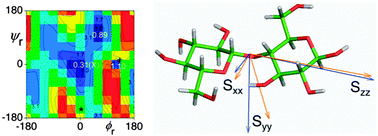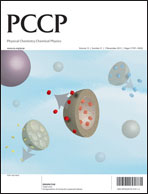Detecting low-level flexibility using residual dipolar couplings: a study of the conformation of cellobiose†‡
Abstract
We have developed novel NMR methods for the measurement of heteronuclear residual dipolar couplings (RDCs) in molecules with severely overlapping NMR resonances. These and other methods enabled us to obtain 31 RDCs for α-D-cellobiose and 24 RDCs for β-D-cellobiose. The interpretation of the data in the approximation of a rigid disaccharide structure, using RDCs and interglycosidic 3J coupling constants, yielded conformation that is very close to that determined using X-ray crystallography. However, depending on which ring was used to calculate the order parameters, the dihedral angle ψH varied up to 30° or 40°, while the ϕH angle was always the same. This indicates residual flexibility of the glycosidic linkage between the two monosaccharide rings and was observed for both α- and β-D-cellobiose. The RDC analysis using rigid fragments rather than a complete molecule has thus shown that the glycosidic bond of cellobiose is not completely rigid and exhibits low-level flexibility. The sources of this flexibility are discussed and evidence presented to support a hypothesis that it is associated with the ψ more than the ϕ angle.


 Please wait while we load your content...
Please wait while we load your content...